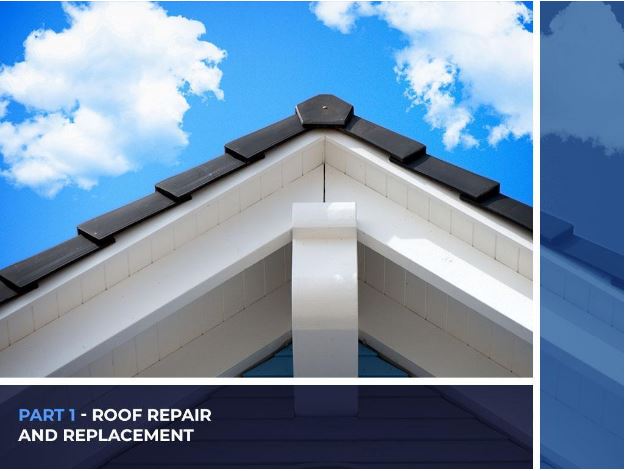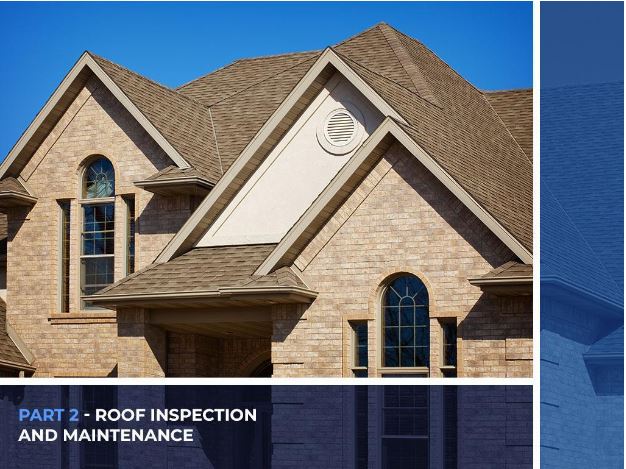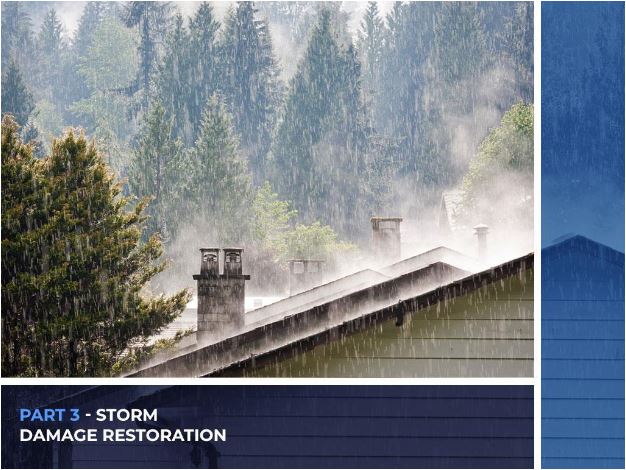Your roofing system is constantly exposed to harsh elements, resulting in wear and tear that often worsens the longer it is overlooked. This paves the way for a number of issues, which ultimately may lead to premature roof failure.
Your roof is a big investment and so it’s important to know how to properly maintain it to help expand its lifespan. We’ve outlined this getting started guide on what you need to know about:
- Roof repair and replacement
- Roof inspection and maintenance
- Storm damage restoration
- Basic residential roof components

Roof Repair and Replacement
Depending on the amount of damage your roof has sustained, your contractor may suggest either roof repair or replacement. But when does one solution make better sense than the other?
You should have your roof repaired when your system has sustained only minimal damage. These may include issues such as loose flashing and torn shingles resulting from high wind speeds. Your contractor can just remove the damaged shingles and install new ones in their place, the flashing can be easily repaired and potential roof openings sealed and caulked.
Not every roof leak calls for a roof replacement. If it doesn’t affect a large area of your home, then all you’ll need is repairs. Your residential roofer can trace the leak’s source and do the necessary patching job.
The same goes for roofing systems that are relatively new. Asphalt shingles, for instance, can last up to 20 years. If your roof isn’t nearly as old, this means the material still has most of its weather-resistant properties and will only need a few quick fixes to keep it looking good and performing well.
Related: Different roof shingle options
How does roof repair benefit you? For one thing, this solution is significantly more cost-effective than a complete roof replacement. Roof repairs also ensure you get the most out of your system’s weather performance capabilities by restoring your roofing to right and extending its life cycle.
You should invest in roof replacement when your system is already past its prime. You can tell when your shingles start to curl, buckle and crack, indicating that the protective granules which help keep extreme weather at bay have already been shed off.
Other worrying signs include large patches of shingles missing from the roof’s surface and recurring leaks that appear in many places inside your home. Severe moisture damage on the roof deck can compromise your home’s structural integrity and safety. If you notice mold and mildew growth inside your attic space, now is a good time to invest in a new roof.
Why is roof replacement beneficial? A roof replacement offers the perfect opportunity to benefit from recent advances in roofing tech. Newer roofs are now made of specially designed materials that can sufficiently meet your weather protection needs at a reasonable price. This means that you can ensure your home remains dry and damage-free. There are also asphalt shingles that come with superior cooling technology so you can benefit from considerable energy savings.
Durable and long-lasting performance, however, isn’t the only advantage a new roof can provide. Given the amount of customization options available – from different colors and textures to high-definition designs and thicknesses – you can choose the roofing system that can help your make a bigger impression from the curb. When investing in this upgrade, however, you need to take into account:
- Roofing material. This affects overall longevity and performance of your new system. Choose the one that can effectively withstand your area’s weather patterns and environment.
- Make sure your choice of roofing matches beautifully with your home’s style and exterior color palette.
- Professional installation. Choose an experienced contractor who can install your roof installation right the first time around.
- Manufacturer warranties. Make sure your new roof comes with solid, extensive warranties covering both material and installation.
Roof Inspection and Maintenance
If you want to keep your home improvement costs at a minimum, it’s a great idea to take measures that prevent issues from forming in the first place. This is especially crucial in your roofing system, a large and complex component that helps keep the harshest elements at bay. Take the time to check its condition periodically or after a major weather event. A storm may have come and gone without apparent incident, but this doesn’t mean your roof has been exempt from damage.

Catch the early indications of damage and prevent them from worsening with a professional roof inspection. Premier roofing contractors have the necessary training for this kind of work, so you’re sure they won’t miss even the slightest hint of damage to your system. They can also provide you with a more accurate assessment of your roof’s condition. Here’s what to expect:
A full interior roof inspection requires your contractor to go into the attic to check your insulation and ventilation. Your contractor will check that your insulation retains expected R-values and that your ventilation is capable of circulating the air within your home adequately. These allow for better thermal consistency, which helps prevent wear and tear on the roof while reducing energy costs. Your inspector may also look for signs of mold and moisture, water damage and sagging on your roof deck.
A full exterior inspection requires your contractor to climb onto your roof to evaluate the wear and tear that it’s sustained. This may include addressing leaks, loose or torn shingles, and even algae growth. Your roofer will also take a closer look at your flashing. Having proper flashing helps keep leak-prone areas protected. You’ll find this essential component around chimneys, valleys, dormers, skylights, vent pipes and side walls.
Following the inspection, your roofing contractor may create an action plan in case any issue needs to be dealt with right away. They’ll also write up a detailed estimate, plus the recommended solutions. With a professional roof inspection, you can prevent damage from getting worse and avoid extensive, costly repair work or early replacement. But, it shouldn’t stop there – you can further maintain your system’s good performance and lengthen its life with regular roof maintenance.
Get a comprehensive roof maintenance plan from your contractor. Like an inspection, this is critical to preventing issues and ensuring your roof remains in tip-top shape. The service may include thorough inspection by a trained roofer, allowing for early problem detection that makes repairs more manageable. Plus, a roof maintenance plan ensures your roof is kept free from debris, which will prevent damage to the material and stop water from leaking indoors. You’ll find that roof inspection and maintenance is your first crucial step to keeping an overall durable and long-lasting system.
Storm Damage Restoration
Roofs are designed to withstand tough weather conditions, but even the sturdiest and most reliable of roofs can sustain damage when hit by an intense storm. If you believe your roof has been damaged by a major weather event, perform a quick inspection by checking on its surface with the help of binoculars. Note, however, that you may sometimes not even realize there are problems until your roof begins to spring leaks.

Wind damage: High wind speeds may blow off your shingles from the roof deck, but sometimes the damage may not be easy to see. The wind may only loosen some of the material, for instance. The seal holding them, however, will wear down eventually. This may cause the shingles to tear free the next time the wind starts picking up.
Hail damage: Hailstorms are something to watch out for: hail can harm your roof upon impact. Like high wind speeds, the damage they leave on your system is sometimes barely discernible. Small cracks and dents may appear on your roof, growing larger and making it easy for water to enter your home.
After a particularly harsh storm, have your roof inspected by a pro, even if it doesn’t look like there’s any damage. When overlooked, small issues evolve into much more extensive, costlier problems as the next storm rolls around. Don’t risk things developing into more serious problems; deal with them promptly.
Here’s how you can effectively deal with storm damage to your roof and home: Hire a reliable roofing contractor for repair and restoration work. They should also know how to handle your insurance claims, which is an essential part of the storm damage restoration process. This way, you can get the compensation you need for the necessary repair work.
Related: How to handle roof damage from a storm
A roofing company that can work with any insurance company is ideal because they can make the process easier and more seamless. They’ll identify the damage to your roof and home with an inspection, document the findings and assist with filing the claim. They’ll serve as the middleman between you and the insurance adjuster, who’ll confirm what’s covered by your insurance.
After everything is completed, they’ll perform the repair and restoration work you need to maintain your home’s structural integrity and your roof’s performance.
Related: How to avoid roofing scams after a hailstorm
Why Is It Better to Hire a Pro?
Any type of roofing job, whether it’s roof repair or a replacement, takes precise work. You’ll need to have the training and experience, plus the necessary knowledge on safety practices, to ensure that the work is done properly. This may be difficult for the untrained homeowner who’s liable to make costly mistakes and unwittingly damage their property. A pro is also especially handy when you need assistance in filing insurance claims.
Learning more about residential roofing jobs can be a big help the next time you experience issues with your system. Because you know what to expect and what to do, you can ensure everything runs more smoothly.
Related: 5 reasons you should only work with an insured roofing company
Basic Residential Roof Components
 When you’re considering hiring a roofing company, it’s helpful if you understand the components of a residential roof. It’s more than just a protective layer on top of your house; it’s a complex system designed to shield, insulate, and enhance the aesthetic appeal of your home.
When you’re considering hiring a roofing company, it’s helpful if you understand the components of a residential roof. It’s more than just a protective layer on top of your house; it’s a complex system designed to shield, insulate, and enhance the aesthetic appeal of your home.
You may be surprised to learn that there’s a lot more beneath the shingles than you expect. All roofs need:
- Roof decking
- Underlayment
- Roof covering
- Flashing
- Roof vents
- Gutters and downspouts
Here’s a closer look at each.
Roof Decking
The roof decking, often made of plywood or oriented strand board, is your roof’s foundation. It’s like a base layer; everything else is built on it. The decking provides structural support and serves as a barrier between your home’s interior and external roofing materials.
Underlayment
Think of underlayment as a protective barrier. It’s a water-resistant layer that roofing experts place directly on top of the roof decking. Underlayment helps prevent water from seeping into your home, especially during heavy rain or snow, and it provides an extra layer of insulation to help regulate the temperature inside your home.
Roof Covering
Your roof covering is the part of the roof you can see from the street. Whether you have asphalt shingles, wood shakes, metal panels, clay tiles or something else, this outer covering is your home’s first line of defense against the elements. It’s incredibly important that you choose a material that complements your home’s aesthetic and stands up to the extremes in Texas weather — we get sun, rain, hail and high winds on a pretty regular basis (sometimes all in the same day).
Flashing
Flashing is a thin piece of material — usually metal — that your roofer will install at intersections or joints of a roof. Flashing’s job is to direct water away from vulnerable areas, ensuring that it doesn’t seep into your home through nooks and crannies. You usually find flashing around chimneys, skylights and roof valleys.
Roof Vents
Proper ventilation is crucial for any home. Roof vents help regulate temperature and moisture levels in your attic, which can help prolong your roof’s lifespan. By allowing hot air to escape during the summer and cold air to escape during the winter, these vents also help keep your energy costs down.
Gutters and Downspouts
Though it doesn’t seem like gutters and downspouts are part of your roof, they actually play a vital role in your roofing system. They channel water away from your home’s foundation, preventing potential damage. Regular maintenance ensures they function correctly, especially during heavy rainfall. That means cleaning them out and making sure they’re free from debris all year.
FAQ About Residential Roofing
Here are some frequently asked questions about residential roof components. If you don’t see the answers you’re looking for here, please call our office. We’re here to help.
What’s the Best Roof Covering for Texas Weather?
The best roof covering often depends on your budget and home style. Metal roofing and asphalt shingles are some of the most popular choices in Dallas and the surrounding communities. That’s because of their durability and resistance to Texas weather conditions.
How Often Should I Check My Roof?
It’s a good idea to inspect your roof at least twice a year, especially after severe weather events. Regular checks can help you spot potential issues before they become major problems. If it’s been more than a year since your last roof inspection, give us a call — your inspection is on us.
Related: Warning signs of an aging and failing roof
When Should I Clean My Gutters?
You should clean your gutters at least twice a year — preferably in spring and fall. This helps prevent blockage and ensures water flows away from your home effectively. If you can’t clean your gutters yourself, it’s worth hiring a professional to do it for you.
How Long Does a Typical Roof Last?
A roof’s lifespan depends on what it’s made from and how well you’ve taken care of it. For instance, asphalt shingles can last 20 to 30 years, while metal roofs can last 50 years or more. Slate roofs and some types of tile can last that long, too.
Is Roof Ventilation Really Necessary?
Absolutely. Proper roof ventilation ensures that your attic has balanced air intake and exhaust. This helps prevent moisture buildup, which can lead to mold growth and wood rot.
Do You Need To Speak To a Local Roofing Company?
Your home’s roof is a complex system designed to protect, insulate and enhance your home. By understanding its components, you can ensure it stays in the best possible condition and protects your home for as long as possible. If you suspect your roof isn’t performing as it should, contact us and we’ll come by for a completely free roof inspection. If everything looks fine, we’ll let you know and be on our way! But if we notice damage, we’ll provide photo evidence as well as a quote on how much it would cost to fix it. Fill out the form on our site or call (469) 423-9808 to book.








